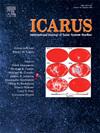Distinguishing potential organic biosignatures on ocean worlds from abiotic geochemical products using thermodynamic calculations
IF 2.5
2区 物理与天体物理
Q2 ASTRONOMY & ASTROPHYSICS
引用次数: 0
Abstract
The search for life in our solar system often involves efforts to detect organic molecules, which have been found on many extraterrestrial bodies, including planets, moons, meteorites, comets, and asteroids. These chemical signatures are not typically thought of as biosignatures because we know that organic synthesis can occur through abiotic processes. Therefore, development of methods for distinguishing biotic and abiotic biosignatures would enable interpretation of data collected from habitability and life-detection missions. Life on Earth harnesses energy-releasing reactions to power biosynthesis reactions, which often require energy. Using thermodynamic data, we can quantify the energy required for organic synthesis. If an organic molecule is detected in an abundance that is thermodynamically unstable, then it is possible that life coupled its synthesis to other energy-releasing reactions. On the other hand, if an organic molecule is detected in an abundance that is thermodynamically stable, then abiotic synthesis was plausible. This sorting framework can be applied to the search for life wherever we have geochemical data. One such example is Saturn's moon Enceladus. Small compounds involving the elements that comprise the majority of biomass were detected by the Cassini spacecraft in the plume gas erupting from the subsurface ocean. Using Enceladus as an example, we demonstrate the utility of thermodynamic calculations for distinguishing biosignatures and show that organic synthesis is often favorable using the carbon sources available on Enceladus. While these results may lead us to conclude that hypothetical organic signatures on Enceladus are abiotic, this framework can be applied to other environments in the search for genuine biosignatures.
求助全文
约1分钟内获得全文
求助全文
来源期刊

Icarus
地学天文-天文与天体物理
CiteScore
6.30
自引率
18.80%
发文量
356
审稿时长
2-4 weeks
期刊介绍:
Icarus is devoted to the publication of original contributions in the field of Solar System studies. Manuscripts reporting the results of new research - observational, experimental, or theoretical - concerning the astronomy, geology, meteorology, physics, chemistry, biology, and other scientific aspects of our Solar System or extrasolar systems are welcome. The journal generally does not publish papers devoted exclusively to the Sun, the Earth, celestial mechanics, meteoritics, or astrophysics. Icarus does not publish papers that provide "improved" versions of Bode''s law, or other numerical relations, without a sound physical basis. Icarus does not publish meeting announcements or general notices. Reviews, historical papers, and manuscripts describing spacecraft instrumentation may be considered, but only with prior approval of the editor. An entire issue of the journal is occasionally devoted to a single subject, usually arising from a conference on the same topic. The language of publication is English. American or British usage is accepted, but not a mixture of these.
 求助内容:
求助内容: 应助结果提醒方式:
应助结果提醒方式:


